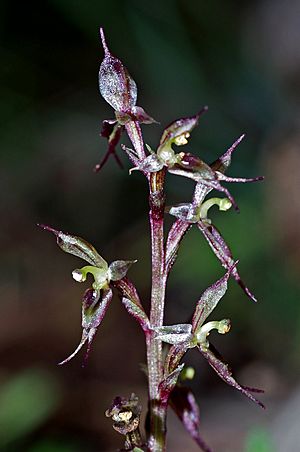Gnat orchid facts for kids
Quick facts for kids Large mosquito orchid |
|
|---|---|
 |
|
| Scientific classification | |
| Genus: |
Acianthus
|
| Species: |
exsertus
|
| Synonyms | |
|
|
The Large Mosquito Orchid, also known as the Gnat Orchid (its scientific name is Acianthus exsertus), is a beautiful flowering plant. It belongs to the orchid family. This special orchid grows only in eastern Australia. It's a plant that grows on the ground, not on trees. It has one heart-shaped leaf. It can grow up to 25 small, delicate flowers. These flowers are usually dark brown with pretty pink and purple marks. You can find this orchid in quiet, protected spots in forests. It grows in Queensland, New South Wales, the ACT, and Victoria.
Contents
What the Large Mosquito Orchid Looks Like
The Large Mosquito Orchid, Acianthus exsertus, is a plant that lives for many years. It grows from the ground and loses its leaves in some seasons. It has a single, smooth, dark green leaf shaped like a heart. The underside of the leaf is reddish-purple. This leaf is usually about 15 to 40 mm long and 10 to 30 mm wide.
This orchid produces between 3 and 25 flowers. These flowers are spaced out along a thin stem that can be 100 to 300 mm tall. Each flower is about 12 to 16 mm long. The top part of the flower, called the dorsal sepal, is shaped like an egg. It is 7 to 9 mm long and about 3 mm wide. It has a red stripe in the middle. This sepal forms a small hood that only partly covers the central part of the flower, called the column.
The side parts of the flower, called the lateral sepals, are 8 to 9 mm long and about 1 mm wide. They are narrow and point forward. The petals are a similar color and are 4 to 5 mm long. They are also narrow and curve towards the part of the flower that holds the seeds. The bottom petal, called the labellum, is 5 to 6 mm long and 3.5 to 4 mm wide. It is heart-shaped and slightly cupped at its base. The labellum has many tiny bumps on its outer half. These orchids usually bloom from March to August.
You can tell this orchid apart from other mosquito orchids. It has larger, darker flowers that are spread out on the stem. Also, its top sepal does not fully cover the column.
How it Got its Name
The Large Mosquito Orchid was first officially described in 1810. This was done by a famous botanist named Robert Brown. The description was published in a book called Prodromus Florae Novae Hollandiae.
The second part of its scientific name, exsertus, comes from a Latin word. It means "to stretch out" or "to thrust out." This name probably refers to how some parts of the flower stick out.
Where it Grows and Lives
This orchid is quite common and can be found in many places. It often grows in coastal areas, but it is more common in mountain ranges and flat tablelands. It likes sheltered spots in forests and woodlands. It grows best in soil that drains water well.
In Queensland, you can find it as far north as Rockhampton. In New South Wales, it grows in most coastal and tableland areas. In eastern Victoria, it grows from sea level up to about 800 meters high.
Looking After the Large Mosquito Orchid
The good news is that the Large Mosquito Orchid is not considered a threatened plant in New South Wales. This means it is not currently at risk of disappearing.

